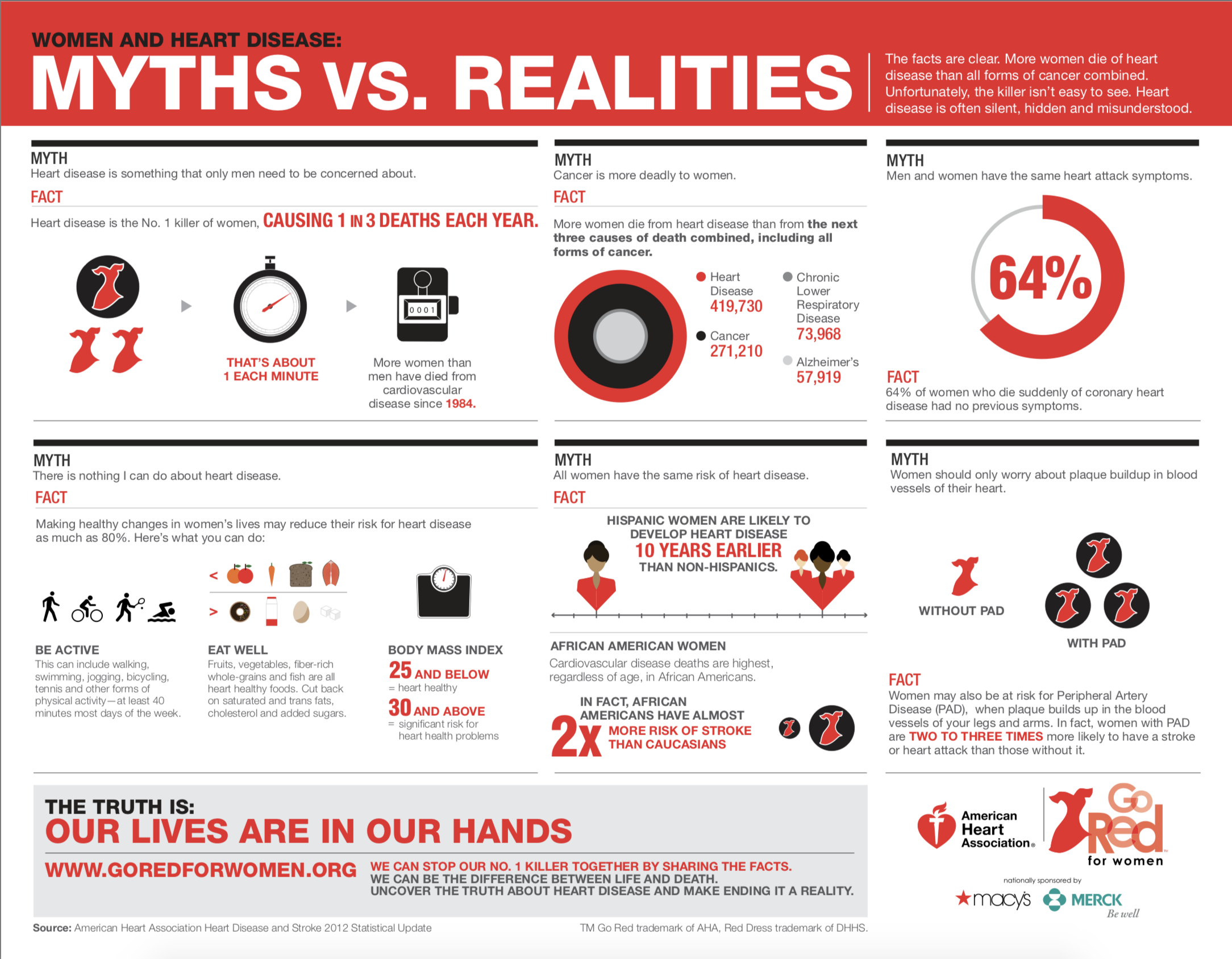You are probably familiar with the American Heart Association’s "Go Red for Women" campaign. Its goal is to raise awareness about heart disease among women. They have a series of add campaigns that use infographics, like the one below, to inform the public. Recently, someone asked me whether those numbers and statements are true (we live in skeptical times) so I thought it would be useful to examine some of the claims in that infographic (seen below).
1. Is heart disease really the number one killer of women?
You would think this type of question would be easy to answer but it actually depends on a number of different factors. First, it depends on whether you look at Canadian or US data because the rankings are different. Next, it depends on whether you consider cancer as one disease or separate it out into different diseases. For example, do you list lung cancer and breast cancer separately or as one single entity? Finally, it depends on whether you count just heart disease or all forms of cardiovascular disease like stroke.
There is no right or wrong way to label data as long as you are clear about what you are doing. I generally think it makes sense to talk about cardiovascular disease as a combination of heart attacks and strokes since they are really two sides of the same coin. Both diseases are caused by the same risk factors (smoking, high blood pressure, diabetes, cholesterol, diet and exercise) and in general have the same treatments. Therefore, it seems fairly reasonable to treat them as one group. I’m less certain that the same can be said for cancer since the causes, treatments, and prognosis for many cancers are so very different.
Regardless of whether you want to rank heart disease as the first or the second most common cause of death in women, it is very common.
2. Do women have different heart attack symptoms than men?
It is often claimed that women have more atypical symptoms than men. The classic symptom for heart disease is chest pain, which is known medically as angina pectoris. The term angina pectoris derives from the Latin angere (“to strangle”) and pectus (“chest”). So while many people think that angina refers to a specific disease, it is really just a descriptive term for the pain and pressure people feel in their chest when their heart is deprived of oxygen by a blocked artery.
Classic symptoms of heart disease are chest pain that occurs with activity or exercise and that goes away with rest. However, people can and often do, experience atypical symptoms of heart disease. Their pain might be more of a burning sensation, or the sensation might occur at rest. Although many believe cardiac pain localizes to the left side of the chest, the geography of the pain is fairly unreliable. Suffice it to say, cardiac pain can present in many different ways.
However, the real question is how often do people present with atypical symptoms and does this differ between men and women? One study that looked at these issues found that the types of symptoms did differ between the sexes, but not by very much. They found that 85.3% of men vs. 81% of women had chest pain when they had a heart attack. So conversely the percentage who had a symptom other chest pain were 19% for women vs. 13.7% for men.
So we can see that women are more likely to have atypical symptoms compared to men, but it is equally true that most women (over 80%) who have a heart attack do actually experience chest pain.
3. Do 64% of women who die suddenly of a heart attack have no previous symptoms?
This statement is also true, as far as it goes. This statistic stems from the 38-year follow-up of the Framingham Heart study. If you died suddenly of heart disease, 63% of women had no prior symptoms compared to 44% of men. This seems like a startling statistic until you realize they looked at sudden deaths. If you looked at all cardiovascular deaths, the percentage of people that had no warning signs was 26% for men and 26% for women. Exactly the same and actually much lower.
|
|
Sudden Cardiac Death |
All Cardiac Deaths |
||
|
|
Women |
Men |
Women |
Men |
|
Without prior heart disease |
63% |
44% |
26% |
26% |
|
With prior heart disease |
37% |
56% |
74% |
74% |
|
|
|
|
|
|
But is this what you really care about?
If you die (suddenly) you have a 63% of not having any symptoms.
I suspect what you really care about is:
If I have no symptoms of heart disease, what is the chance that I will die?
We can get the answer to this question from the same study. It found that women with no previous heart disease had an age-adjusted death rate of 0.8 deaths per 1000 women. Women with angina had 2.4 deaths per 1000, and women with a prior heart attack had 4.6 deaths per 1000. In case you are interested the numbers for men were 1.5/1000, 9.1/1000 and 17.5/1000.
|
|
Women* |
Men* |
|
|
No heart disease |
0.8 per 1000 |
1.5 per 1000 |
|
|
Angina |
2.4 per 1000 |
9.1 per 1000 |
|
|
Prior heart attack |
4.6 per 1000 |
17.5 per 1000 |
|
* age adjusted annual death rates per 1000 individuals
So if you die (suddenly) you might not have had prior symptoms, but if you do not have any symptoms, the chance that you will die suddenly is actually pretty low (less than a tenth of one percent) and you are more likely to die of heart disease if you actually have symptoms.
There are many myths and misconceptions about heart disease and women. Some are true, some are false, some are only partly true, and most are far less scary when you turn the statistics on their head. After all, as Mark Twain once said, “There are lies, there are damned lies, and then there are statistics.”
Want to engage with this content? Comment on our Facebook Page!








